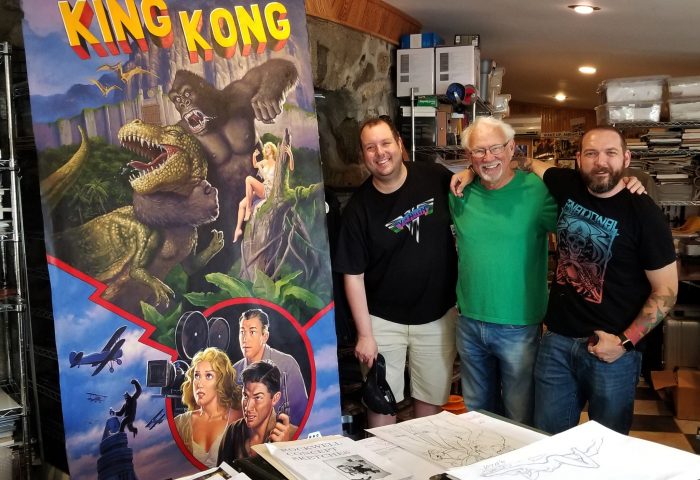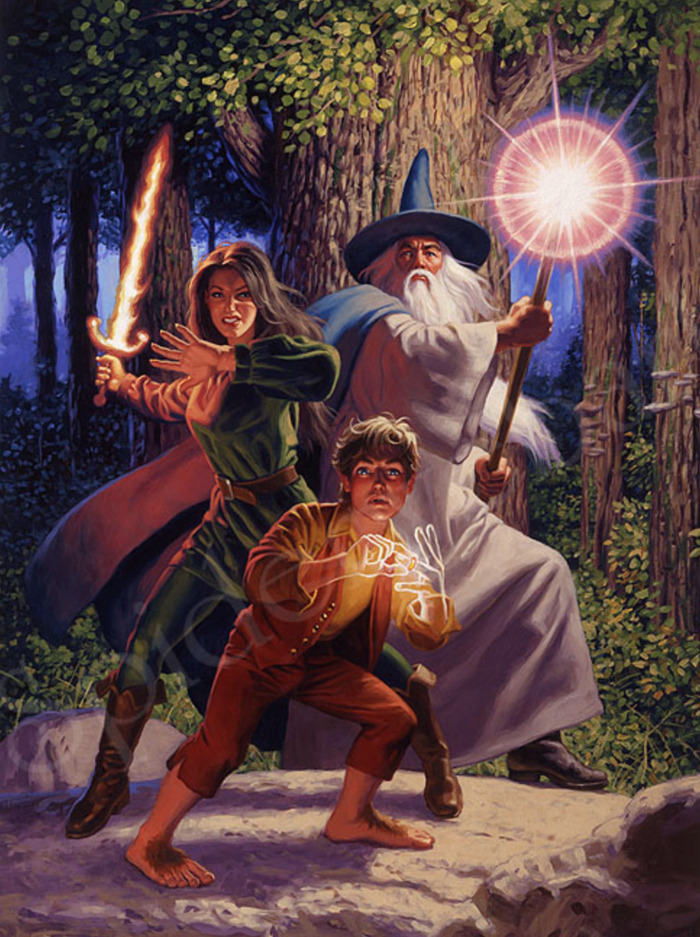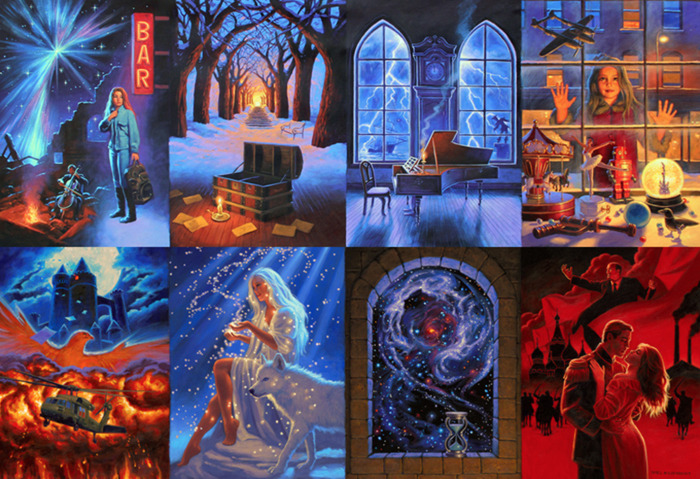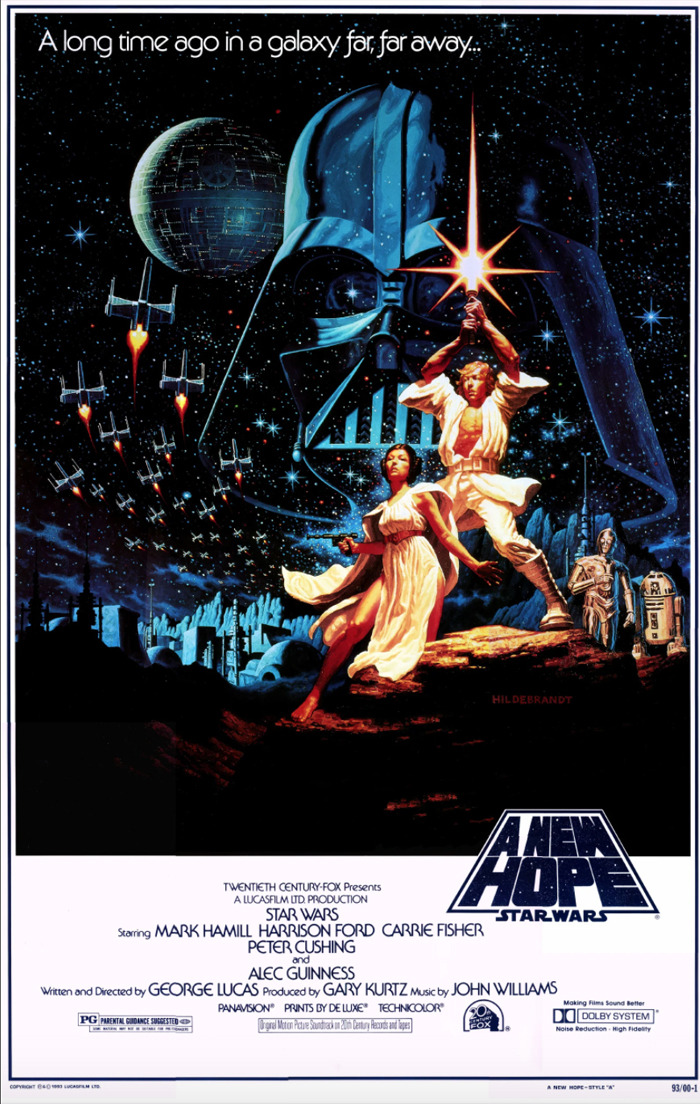This Famous 'Star Wars' Poster Was Created In Just 36 Hours
Erik Sharkey and Kevin Burke love movie posters so much that they've both made movies about them. Erik directed a film about legendary poster artist Drew Struzan titled Drew: The Man Behind the Poster, while Kevin directed 24x36: A Movie About Movie Posters, which examined the birth, death, and resurrection of illustrated movie poster art. Now the two filmmakers are joining forces to make a film about one of the most famous illustrators to ever work in the science fiction and fantasy genres: Greg Hildebrandt.
If you don't know Greg's name, you definitely know his work. He and his brother Tim, who died in 2006, whipped up an early Star Wars poster that instantly captured the imaginations of fans around the world. That alone would be enough to put these guys into the legend category, but Greg, now 81 years old, has also had a decades-long career spanning franchises and companies like The Lord of the Rings, Harry Potter, Marvel, Magic: The Gathering, and even the Trans-Siberian Orchestra.
I spoke with Sharkey and Burke about their plans for their new documentary, and also had a long chat with Greg Hildebrandt himself about the creation of that famous Star Wars poster and much more.

It's clear that both Sharkey and Burke are genuine fans of Hildebrandt's work, and that passion fuels their desire to put his story on film. "You think about all of the great movie posters – the Hildebrandt brothers' Star Wars poster or Drew Struzan's Back to the Future poster – they get the spirit and the tone of the film in just one image," Sharkey told me over the phone. "And then there's just the mastery of it: the way they put paint on a canvas, the power of composition, the power of lighting. It's not only great movie poster art, it's just great art in general."
But isn't the act of illustrating sort of inherently un-cinematic? How do these guys plan to overcome that obstacle? They plan to animate some of his work to help bring it to life on the screen, but Burke has a more human answer as well. "Not only is Greg an absolutely wonderful illustrator, which allows us to lean into the magic of the worlds that he creates to create a visual sense of our own that in some ways mirrors that, even for a documentary...but also he's a very, very compelling person with an incredibly interesting story to tell. At the end of the day for any documentary, it's about making that human connection. Greg, for all his fame and celebrity and the otherworldly nature of his art, is still very much a human and a worldly man with a lot of interesting things to say and an incredibly interesting life story."
Sharkey also thinks it's "really important to tell these artists' stories while they're still here." Since many of Greg's contemporaries have passed away, he says "it's important to get all these stories now to pass on to future generations, because Greg is a part of a tradition and an era of artists that had such an impact on illustration, our lives, and pop culture." The directors have shot a large part of the film already – extensive interviews with Greg and other artists, seeing Greg in action at New York Comic Con, etc. – but they still have some additional editing and interviews to record, and you can follow their progress on the movie's Facebook page.
Here are some highlights from my conversation with Greg Hildebrandt, touching on a few of the major pop culture properties he's worked on throughout his career.
The Lord of the Rings
"I worked in an animation studio in Detroit, where I started my career, so I always think in terms of film [when doing my artwork]," Greg told me during our interview. "Movement, action, and motion. For me, most of the illustration and paintings that I've done, I'm not decorating a page. Which is a beautiful concept...but I feel like I'm trying to create a doorway into a real world that you can actually step into and be part of."
You can feel that immersion in much of his work. Browsing through a selection of his illustrations, I'm struck by the sense of tactile warmth he's able to bring to his images, as well as the striking action of the larger than life characters he captures – especially in the realm of Tolkien's fantasies. After reading The Hobbit and The Lord of the Rings, Greg and Tim knew they wanted to work in that world in some capacity one day. He never got to meet Tolkien, who died just before they finally got the job, but in the late 1970s, they became famous for their work illustrating Tolkien calendars for Ballentine Books, which essentially turned them into rock stars in the fantasy art world.
Trans-Siberian Orchestra
Again, if this name doesn't immediately ring a bell for you, it's a guarantee that you've heard their work. Mixing classical music with rock opera, TSO is known for their albums of Christmas music. Songs like "Christmas Eve Sarajevo 12/24" and "Wizards of Winter" have been used in advertising and viral videos for years, and Greg eventually became one of the primary artists who contributed to the band's mythos.
"I've never been so affected by something in that sense where it took me over," he said of the first time he listened to Beethoven's Last Night, the band's third album. So inspired was he by the music that he would stay up at all hours of the night creating imagery prompted by what he heard, "with no concept or thought or feeling or belief that I would ever do anything with it, I just had to get the imagery out that I was feeling and seeing." Greg worked on it for three months, and when he finished it, his wife and business manager Jean got in touch with TSO frontman Paul O'Neil, who had been a fan of Greg's work since his Lord of the Rings days in the 1970s. That mutual admiration led to Paul using Greg's work on a re-issued cover of the album, and kicked off a long working relationship that included Greg creating several album covers, program illustrations, posters, and more.
Star Wars
"That's a fluke, that job," he says of his most widely-known work. In the late 1970s, the brothers were working on general illustrations – which essentially meant that they took whatever gig came their way. After creating illustrations for a toilet training book, they decided they wanted to work on "something a little more romantic," so they opened the phone book and cold-called an art studio in Manhattan that handled movie posters – and to underline how different things were at that time, the guy on the other end of the line didn't immediately hang up on them, but instead told them to bring their portfolio over. "In those days, they did that," Hildebrandt explains. "You could call an art director or an editor at a publishing house and have a conversation with them."
When he and Tim arrived at the New York studio, there were paintings all over for Mel Brooks' Young Frankenstein. As huge fans of Brooks' work, the brothers begged to do a poster for the movie, but the editors explained that they didn't have a budget for another poster and the current ones were being shipped to California the very next morning. Plan be damned: Greg and Tim designed a poster of their own on the train back to New Jersey, created the entire layout, took some photos for reference once they arrived at their own studio, and banged out a painting overnight with no sleep. "It didn't get used," Greg says, "but these guys were blown away that we came in the next morning with a painting."
"A couple years go by, we get famous for our work on The Lord of the Rings, and a phone rings," Greg continues. "These guys from the studio said, 'You've gotta help us out. We've got a sci-fi film here, the film's being released in a week and the director's not completely satisfied with the poster he has.'" Tom Young had already created a version of the poster, but they told the brothers that George Lucas wanted a new poster to have "this basic set-up, but he wants it more comic book-y."
Left with only that vague direction, they decided that meant "stronger color, higher contrast," and that the ships should be "a little sexier." The studio needed the work as fast as possible, so the guys worked for 36 straight hours to finish the picture. "They were flabbergasted that we did it," Greg says, and he suggested adding a couple of other characters in the background – "like the big hairy guy. I didn't know who he was," Greg laughed. "These guys never saw the movie. They had no idea what it was themselves. I said, 'What's it about? Who's this guy with the helmet?' and they said, 'I don't know, the Man in the Iron Mask or something.'" The original agreement – which, crucially, was just a handshake agreement – was for Fox to use their image outside the theater and in newspaper ads. But it ended up as a merchandised product: on T-shirts and all sorts of other places beyond those agreed-upon bounds.
Not only that, but the Hildebrandt brothers never got the original painting back. There was no agreement that the studio would hang on to that, but "in the heat of the moment, everything was so fast," Greg says. Six months went by, and Greg and Tim still hadn't been paid for their work on the poster. Greg ended up suing 20th Century Fox, but Fox's lawyers – who were presumably still stinging from realizing that they had signed merchandising rights away to George Lucas – said they would fight hard against Greg's claim to money from reproducing their image on shirts.
Eventually, the lawyers said they would double Greg and Tim's original price of $4,000. "I said, 'Great!'," Greg remembers. "Then the lawyer sent me his bill, which took up four thousand dollars and got us back to the original four thousand dollars. So Tim made two thousand off that picture, I made two thousand. Everybody assumes to this day that somehow, we as artists who did the painting became super millionaires or some god damn thing...but, it's still there. People still recognize it."
As for that Young Frankenstein poster the brothers painted over the course of that one frenzied night, that painting has since been lost. Greg has tried to find it, but suspects it may have been swiped from the office and simply taken home by a higher-up at the studio. But at the end of the day, he's just thankful it served as a springboard to bigger things. "I have no idea where it is. Maybe Mel Brooks has it, I don't know. But when people ask me who I'd like to thank about doing the Star Wars poster, I do say Mel Brooks."



